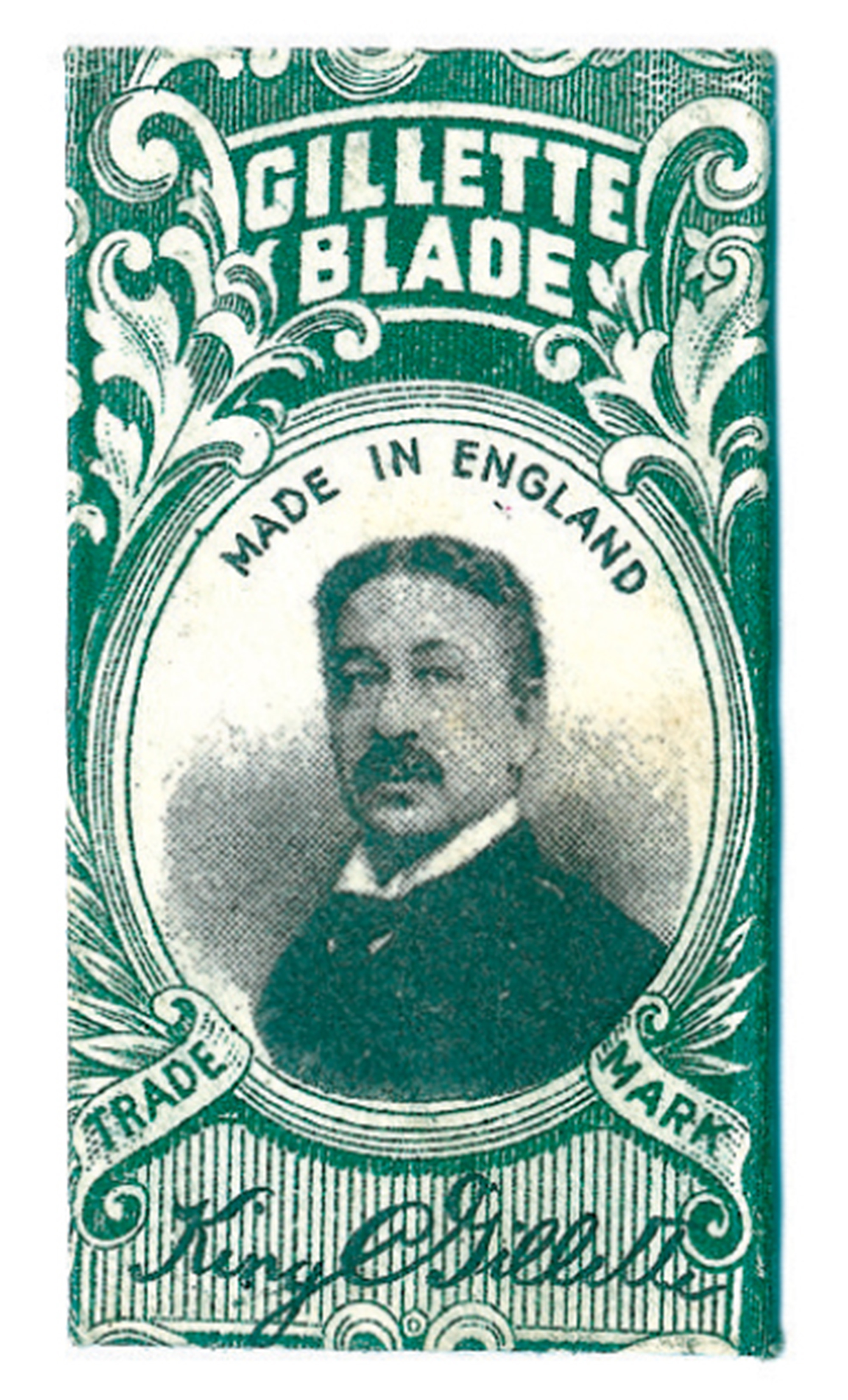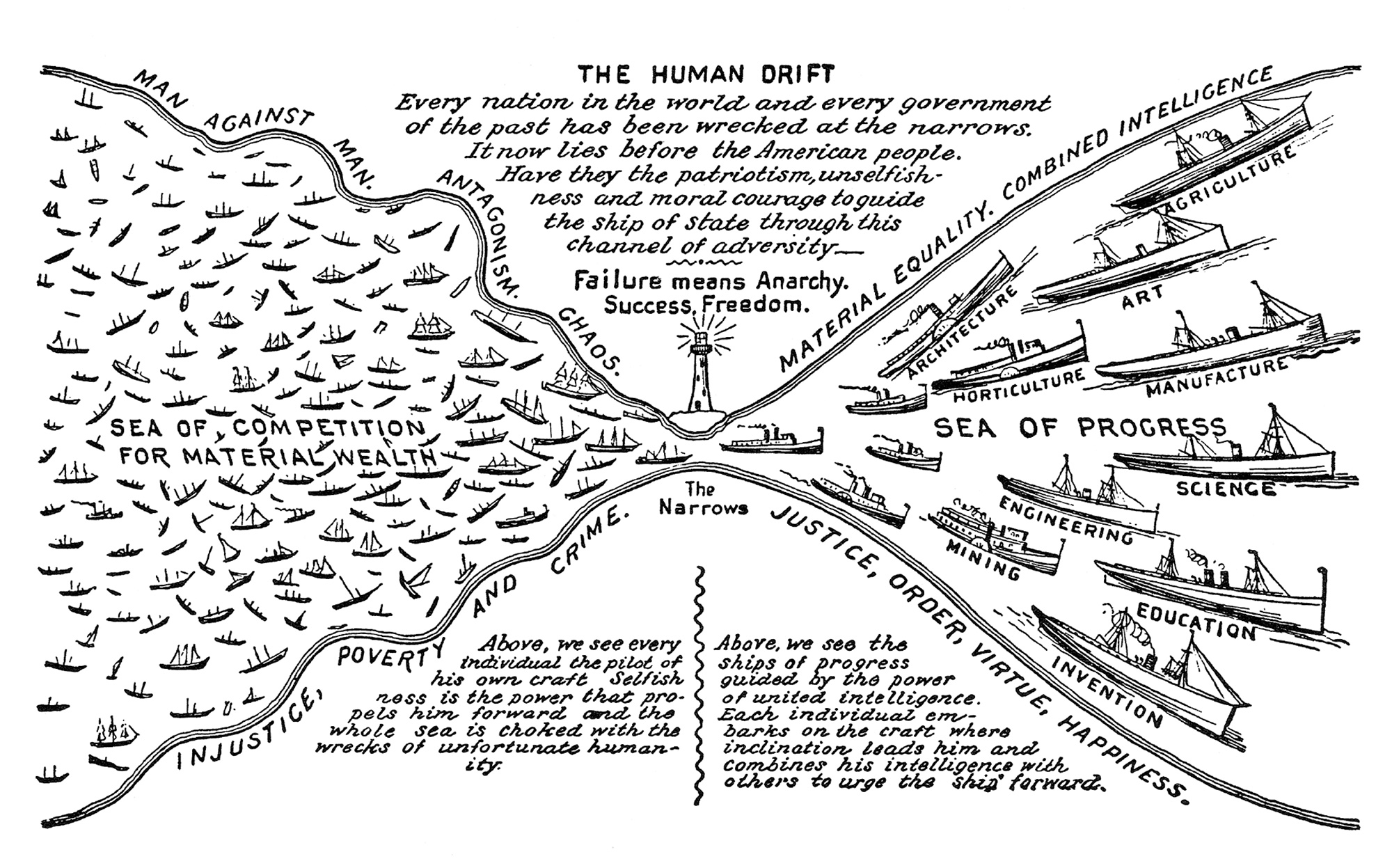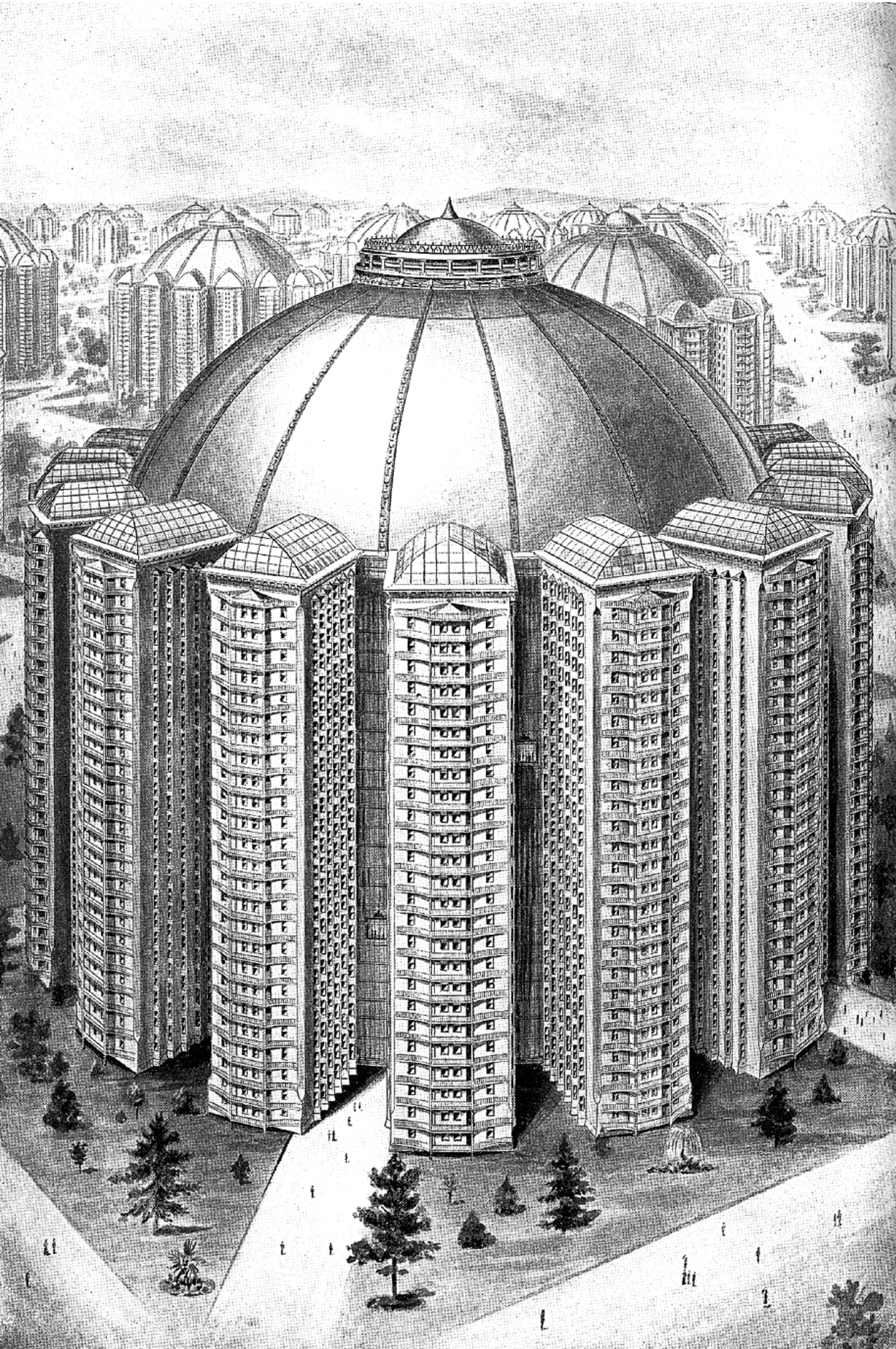Looking Forward
King Camp Gillette and the dream of Metropolis
Paul Maliszewski
There was once supposed to have been a city, located not far from Niagara Falls, where 60 million people lived in 24,000 apartment buildings, each 25 stories tall. In Metropolis, as the city was named, the apartment buildings were arranged in a regular pattern and served as the central hubs or cogs around which life there revolved. Short, neatly landscaped walkways connected the buildings together and led to wider and longer avenues that crisscrossed through the city. Schools, recreation and amusement centers, flower conservatories, parks as ample as they were well-planted, and buildings for food production and storage clustered around every apartment building, each of which accommodated about 2,500 people in comfort and high style. According to the city’s creator, “the most magnificent modern hotel in New York could not compare in beauty of its rooms and liberality of its service with any one of these thousands of buildings of Metropolis.” Indeed, individual apartments promised a lavish, if not obscene 4,500 square feet of living space, which was divided into three bedrooms, three bathrooms, three sitting rooms adjacent to the bedrooms, a library and music room, as well as a window-lined parlor and veranda for entertaining guests. An expansive glass-domed room, located at the center of the apartment buildings, offered a communal dining area. In all, the city encompassed 15,000 miles of avenues, “every foot of which would be a continuous change of beauty.” It extended east into New York State and, pending the cooperation of the Canadian government, west into the province of Ontario. It drew much of its power from the Falls and the Niagara River. The residential portion of the city alone—that tightly woven honeycomb pattern of apartment complexes and ancillary buildings—lay just south of Lake Ontario and subsumed sizable parts of seven upstate New York counties, from Niagara and Erie in the west to Ontario and Wayne in the east.

Metropolis never did exist, however, except in the elaborate and detailed pages of The Human Drift, an 1894 utopian tract by King Camp Gillette. Born in 1855 in Fond du Lac, Wisconsin, Gillette was the youngest of seven children. His mother wrote a well-known cookbook that is, remarkably, still in print, and his father owned a wholesale hardware business and worked as a patent agent. Gillette was a restless tinkerer. He sunk nearly $20,000 into an ultimately failed quest to create a carbonating machine and later traveled the country as a salesman for a firm that manufactured corks, bottle caps, and stoppers. Seven years after formulating his blueprint for a better and certainly more organized city, Gillette, then forty-six years old, invented the safety razor, a commercial product that became the basis for a thriving company and made its inventor a multimillionaire and one of the few celebrities known the world over. An early president of the company recalled that when Gillette visited Egypt, locals recognized him from his picture, which was printed on every razor’s wrapper. They surrounded the inventor and pointed at him eagerly, scraping at their faces with bent forefingers.

Disposable razor blades proved a considerably easier sell than the new way of life promised in a not-yet-built city of the future. And yet, Gillette had good reason to expect that people would line up to buy new and improved futures as well. He had dedicated his book “to all mankind,” and then added, “for to all the hope of escape from an environment of injustice, poverty, and crime, is equally desirable.” The United States had recently fallen into a deep economic depression, the worst in its history, brought on by the currency crisis of 1893 and made worse by the predatory practices of business owners (“robber barons” in the honest parlance of the time), who were hell-bent on merging and acquiring and combining and growing, all as rapidly as possible. Stock trading was so speculative and unregulated it earned frequent comparisons to gambling. The age was called gilded: on the outside it glittered like gold, but underneath it was bad fruit, rotten and soft. Severe unemployment and hundreds of failed banks further exacerbated the nation’s misfortunes. Railroads were bought, sold, and traded feverishly, eventually gutted of their value and left as empty husks to operate in unprofitable receivership. The nation’s cities were not appreciably different from what Jacob Riis witnessed in New York City’s tenements and described in How the Other Half Lives (1890): dangerous and impoverished, ridden with crime and communicable diseases. Life had become so nasty and brutish that people must have felt justified in wishing it at least be mercifully short. President Grover Cleveland, tone deaf to the tune of the times or else unable to imagine any solution save waiting and seeing what happened next, greeted the not unreasonable demands of some striking workers by dispatching the U.S. army to crush them.
Not surprisingly, the last years of the nineteenth century proved to be fertile soil for discontent and produced both a bumper crop of utopian schemes and people to dream them. If necessity is the mother of invention, poverty and hardship are the parents of utopian proposals. According to Russell Jacoby, author of The End of Utopia, at least one hundred utopian novels were published during the last twelve bitter years of the nineteenth century. The most popular by far was Edward Bellamy’s Looking Backward: From 2000 to 1887, which imagined, with not a little optimism, that the twentieth century would lick the nineteenth’s problems and the new millennium would dawn brightly on a world that had achieved equality, peace, and an end to crime, want, and poverty. The book sold 5,000 copies a week in 1888 when it was published—only Uncle Tom’s Cabin shifted more units that century—and was translated into more than twenty languages, including Chinese, Japanese, Hebrew, and Lithuanian. Seven separate translations circulated in Russia, with the first inspired by Tolstoy, who considered Bellamy’s book an “exceedingly remarkable” achievement. According to Scott McLemee, who in late 2000 took stock of what Bellamy had wrought, Looking Backward spawned countless imitators as well as clubs for readers devoted to discussing the original’s teachings and implications. Writing for the New York Times Book Review, McLemee suggests that Bellamy’s genteel readers were “relieved to think that society could be improved without violent revolution.”
Gillette was one such mild-mannered reformer. He acknowledged that the world as it worked was a broken machine, but was possessed of such an even temperament that he sought reasonable solutions to even the most intractable problems. Though many of his criticisms of the social order were acidic—Gillette wrote that both U.S. political parties were “wedded to boodle, and managed and controlled in the interests of capital”—and though many of his ideas had a distinctly socialist complexion, Gillette refused to embrace that ideology and never thought of himself as an enemy of capital. His solution instead was to propose a practical and corporate-minded fix designed to appeal to working people and business owners alike. Business, Gillette believed, could repair the world of troubles that business had itself made.
In The Human Drift, the creation of Metropolis is but the second part of Gillette’s ambitious solution. In order to raise the money necessary for the construction of his city, he planned to create a new corporation, a behemoth to dwarf and, finally, dominate all existing companies. Following the merger-merry spirit of the age, the new company would assume control of the competition, eventually monopolizing every single smaller and weaker enterprise. It would bring all other companies to heel. Unlike those other firms, however, Gillette’s United Company would be owned jointly by all people, all equally. Individuals could buy stocks in the United Company just as they could any publicly traded firm, but regardless of how many shares they owned, every shareholder received but one vote to ensure that the firm always operated in the interests of its collective owners, the world’s people. To make buying a piece of that future easier, Gillette included a certificate of subscription in his book for the interested investor to detach, fill out, and mail in.
Gillette’s idea of one company to rule them all benevolently was not new. Looking Backward predicted the creation of a massive state-owned and -operated trust that would deploy, as Jacoby writes, “the nation’s wealth to ensure perfect financial equality for all.” The novelty of Gillette’s idea lay in his abiding faith that private enterprise, acting within the existing market economy and without government’s help or interference, could achieve that goal. Gillette believed that the corporation—taken to its ultimate conclusion—could solve all problems. His commitment to social reform was real, but he remained a businessman in both his ideas and outlook. Later, Gillette referred to this firm, even more grandly, as the World Corporation and The People’s Corporation, but while its name changed, his central idea held steady: a corporate monopoly, the cause of so much that he identified as socially noxious—competition, Gillette thought, lay at the root of every one of the problems that beset society—could still be bent to good purposes. He was a businessman with a socialist’s heart. And he believed the country’s future could be secured only by taking a counterintuitive leap of logic, the same sort that inspired scientists then to create a cure for diphtheria by using diphtheria itself.
As the United Company grew, the assets it accumulated from sales of shares and the creative destruction of its dwindling rivals would be funneled straight into the creation of Metropolis. The North American continent, Gillette believed, needed no more than one city of its size. One well-designed city was more desirable than thousands of smaller, deeply flawed, and badly operated runts. The United Company’s success came at a steep price though. Thousands, if not millions, of people would lose their jobs and be made redundant by the colossal company of the people. All those unlucky workers would be taken care of, however, and employed in the earliest stages of the construction of Metropolis.

Gillette had it all figured out. In The Human Drift, he tried to foresee and address every eventuality, from the location, size, and shape of the buildings to minute details of their design. The city would start from the ground up, developing in layers like a cake:
In the building of “Metropolis” there would be no excavating for sewage, heating, cold air, and electric systems. Each would be above ground and in plain sight, where every defect could be noted and repairs made without unnecessary labor. To accomplish this, a chamber is formed above ground by the erection of steel pillars and the building of a platform throughout the length and breadth of the city. The pillars used are of such different height as to overcome the inequalities of land surface, and make it possible to lay a perfectly level platform at the top of the pillars, it being calculated to be elevated at least twenty-five feet from the ground. This platform is composed of frameworks of steel inlaid with glass, similar to the numerous vault lights of our cities, which admit light to cellars and basements. We now have a perfectly level floor of glass and steel throughout the city, and the chamber beneath that platform is as light as day.
Gillette further prescribes two more layers, constructed along similar lines, with the second reserved for the city’s transportation system and the third made expressly for storage and a spacious walkway, which he considered “desirable in inclement weather.” Even building materials and colors are specified here. The first layer would be white, with the ground “first covered with a cement or asphalt composition, and then a layer of white glazed tiling.” The second layer “would also be treated in white tiling, relieved by colored borders.” For the third layer, which Gillette envisioned as a “bewildering scene of beauty in its artistic treatment,” he pulls out every stop:
The floors, ceiling, and pillars of porcelain tile, with their ever-changing variety in colors and designs, the artificial parks topped above the upper platform with domes of colored glass in beautiful designs, its urns of flowers, and beautiful works of art and statuary, would make it an endless gallery of loveliness. Here would be found a panorama of beauty that would throw into shadow the fables of wonderful palaces and cities told of in the “Arabian Nights”; yet the genii of all this would be naught but the intelligence of man working in unison. What would be seen here is within our knowledge to do, and with less expenditure of labor than is now required to maintain our present cities.
Gillette calculated for every need save one: interested homeowners. Not that he lacked for at least one champion. Twentieth Century, a populist weekly magazine, took to advertising The Human Drift as part of its five-volume set of reform-minded literature, which included Looking Backward and essays by George Bernard Shaw. The magazine even formed a corporation, inspired by Gillette’s proposal, and called it Twentieth Century Company. Gillette was declared its president, and the magazine wasted no time in bidding readers to buy shares at five dollars a pop. Later, the company’s directors abruptly announced it would break into the insurance field. Next, they took control of a printing company, their first acquisition. Russell B. Adams, Jr., the author of Gillette’s only full-scale biography, describes that transaction as “fittingly cashless.” The directors, who never seemed all that deliberate about executing Gillette’s plan, had little money and so could afford to bank only on good-hearted ideas and their bottomless enthusiasm for a better future. Investors meanwhile didn't flock to the company, and readers never really warmed to Gillette’s theories.

Their lack of interest was writ large in the 1896 presidential election. The most reform-minded voters that year lent their support to the Democratic Party and William Jennings Bryan. Their political decision, however cagey and based on notions of what we might now term electability, was for naught. The country chose William McKinley, a Republican who enjoyed the fealty of bankers. Adams notes that within two years of McKinley’s victory, Twentieth Century published its last issue. “The radical weekly,” he writes, “had failed even to survive into the century that had inspired its name, thereby more than living up to its motto, ‘Always ahead of the times.’”
The American left has become so accustomed to such grim irony in the face of defeat that it can seem now like a crucial plank in its political platform. But before relegating Twentieth Century and Gillette to the dustbin of well-intentioned ideas and fanciful notions, it’s worth asking if there isn't something worth saving. Kenneth M. Roemer, an English professor at the University of Texas at Arlington who has written frequently about Gillette, including the introduction to a 1976 facsimile of The Human Drift, its most recent edition, argues that “Gillette’s grand plans, even if they were grand delusions, deserve better” than casual mockery of his outsized ambition and naïveté. For Roemer, Gillette captures distinctly nineteenth-century concepts of how corporations increasingly played a role reserved, during earlier eras, for religion. But beyond the historical significance of The Human Drift and its oddly angled snapshot of turn-of-the-century anxieties, maybe it possesses a more timely value—perhaps even a timeless one.
Utopian tracts, and novels too for that matter, needn't be read as blueprints. As plans that stipulate specific actions—a specific city built on a specific hill by specifically designated workers—they always and inevitably will founder. But does it represent the failure of utopian writers when what they predicted has hardly come to pass? Or is it our fault—our collective fault—that so much is still so wrong, unequal, and unjust? Journalist Heywood Broun writes in a 1926 introduction to Looking Backward that his radical friends routinely condescended to the novel, forever reminding him that first-rate economics didn't inform Bellamy’s thinking. And yet, Broun argues, many of those same friends granted that the novel first inspired them to start thinking about inequality and next consider what was to be done. In Metropolis, no building was ever made. No ground was ever broken, and no team surveyed the site. But as calls to our better selves, utopian literature might still succeed. Gillette and Bellamy and other utopian writers remain a group of unappeasable instigators, a hard-to-impress tribe forever facing the future, still there to inspire a few more restless dreams of better worlds and hopes that may be realized yet.
Paul Maliszewski’s writing has been published in Harper’s, The Paris Review, Granta, and the Pushcart Prize anthologies. His last piece for Cabinet appeared in issue no. 15.
Spotted an error? Email us at corrections at cabinetmagazine dot org.
If you’ve enjoyed the free articles that we offer on our site, please consider subscribing to our nonprofit magazine. You get twelve online issues and unlimited access to all our archives.